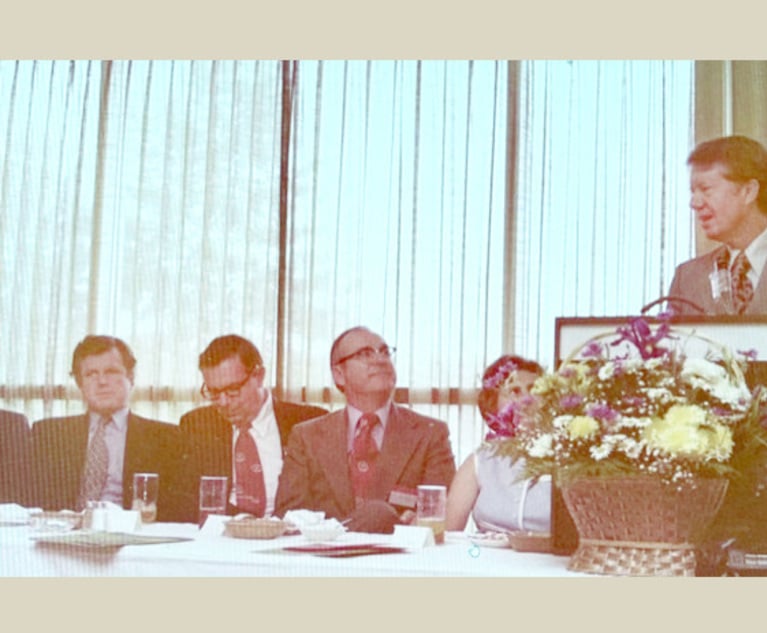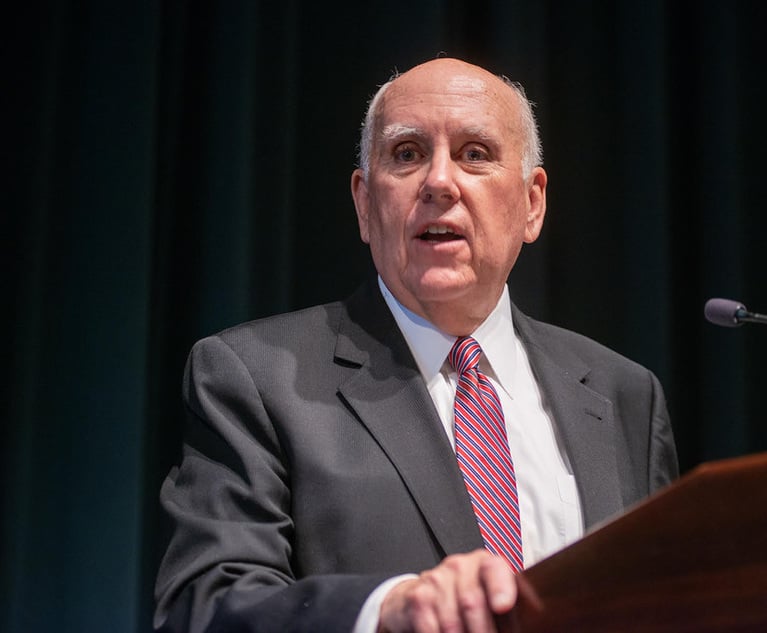Hollering Justice (and Judges)
Does society need retribution in the form of a judge pointing her finger at the defendant using the same kind of invective that one might see—and, indeed, expect—from an individual victim?
January 31, 2018 at 12:20 PM
5 minute read

Suppose you're a woman who was raped while still in your teens—your life basically shattered. For the last 10 years you have barely been able to look any man squarely in the eye given what was done to you by just one horrible man. You have just recently overcome your overarching fear of intimacy, and now, finally, the rapist has been caught, and has pleaded guilty to what he did to you and others.
You have reached that moment for personal closure, assuming that is even possible, and maybe even revenge. But you can finally stand up to your full height in a public courtroom, stare him in the eye and tell the world exactly what he did to you and the impact it has had. And people will listen—you will be heard. You practice in the mirror 10 times a day for a week, and finally you're in the courtroom no longer afraid to stare the man in the eye. And you are closer to being free. This “release,” as it were, is precisely what any therapist would have ordered, and society has agreed with the wisdom and propriety of victims confronting their perpetrator. That is why the courts allow victims to appear in court at sentencing, to point their fingers at defendants in such cases, and speak truth to those who previously had all the power against them.
And, of course, it should be exactly that way—probably every victim needs to be heard, to face their abuser, as a critical element of the personal healing process. Society, the public—we need to hear you as well. To understand and appreciate the impact that that person had on your life and the lives of others. With appropriate decorum exhibited in the pristine atmosphere of a courtroom, victim impact statements should indeed be a foundation of the sentencing process.
But let's look at that final day of sentencing in the case of Larry Nassar. The man deserves no forgiveness, no pity. Nothing could serve to mitigate what he had done for decades. Yet, did Judge Rosemarie Aquilina of Lansing, Mich., who has been heralded in many quarters for her conduct when sentencing Nassar and been given a screenshot on the front page of The New York Times, go too far? Not by allowing more than 150 of Nassar's victims to address him and tell him in the starkest terms what he had done; his victims should tell him, the court and all the world what he had done.
But when it came time to impose sentence, Judge Aquilina's final words to Nassar were angry and vehement. She did not render her sentence dispassionately. Instead she told Nassar that she had the “privilege” to sentence him; that his actions were “devious” and “despicable.” She told him that, if the Constitution allowed, she might allow others to do to him what he did to his victims. And finally, to applause in the courtroom, as she essentially solicited: “I just signed your death warrant.”
Does society need retribution in the form of a judge pointing her finger at the defendant using the same kind of invective that one might see—and, indeed, expect—from an individual victim? Is society better off—indeed, are the victims better off—if the judge herself or himself lashes out at a defendant for his crimes, however horrible, as if he or she was the victim who had personally suffered at the hands of the defendant? Should we want judges to basically descend from the bench and the majesty of the position they hold, stand in the well of the court and become finger pointers—trash talkers, as it were—as if they themselves were now empowered victims? Just how much should a judge relate to those harmed?
While there is often indeed value in a judge giving a strong tongue lashing to a reprehensible defendant who has so victimized others, particularly those who are so vulnerable, the judge's role is to hear from both sides, make a determination of the appropriate sentence and, yes, in some cases, stick it to the defendant. But Judge Aquilina did something far different—she went “medieval” on Nassar, behaving like a robed Elmer Gantry and, in doing so, compromised the dignity of her courtroom.
I expect she meant well, and had truly empathized with the victims who spoke so bravely (and sufficiently for its true purpose) in her courtroom. And maybe the judge thought saying those harsh words might deter others. Nonetheless, the criminal justice system is composed of different players who have different roles. The judge is not the prosecutor, and she certainly isn't the victim.
To be sure, Nassar, is not a victim here in any way. However, especially with cameras in the courtroom—and maybe that's a reason to deny them, given that the judge may have been playing to the world outside her courtroom—imposing a 40- to 175-year sentence (to run after his previously imposed 60-year sentence) might have truly done the deterrence trick without the hang-him-high “death warrant” language.
Nassar must be punished for horrific acts. And deterrence—a message to others—is a key component of sentencing. But Judge Aquilina's words have turned the story to her and whether she went too far? That is not what the girls' stories are about; and that is not what making sure Nassar never sees the light of day is about. We often need bold action from judges, yes, but never performance.
Joel Cohen, a former prosecutor, is of counsel at Stroock & Stroock & Lavan. He is an adjunct professor at Fordham Law School and is the author of “Blindfolds Off: Judges on How They Decide.”
This content has been archived. It is available through our partners, LexisNexis® and Bloomberg Law.
To view this content, please continue to their sites.
Not a Lexis Subscriber?
Subscribe Now
Not a Bloomberg Law Subscriber?
Subscribe Now
NOT FOR REPRINT
© 2025 ALM Global, LLC, All Rights Reserved. Request academic re-use from www.copyright.com. All other uses, submit a request to [email protected]. For more information visit Asset & Logo Licensing.
You Might Like
View All
Jimmy Carter’s 1974 Law Day Speech: A Call for Lawyers to Do the Public Good
14 minute read
For Safer Traffic Stops, Replace Paper Documents With ‘Contactless’ Tech
4 minute read
Benjamin West and John Singleton Copley: American Painters in London
8 minute readTrending Stories
- 1Data Breach Lawsuit Against Byte Federal Among 1,500 Targeting Companies in 2024
- 2Counterfeiters Ride Surge in Tabletop Games’ Popularity, Challenging IP Owners to Keep Up
- 3Health Care Data Breach Class Actions Saw December Surge in NY Courts
- 4Florida Supreme Court Disbars 3, Suspends 11, Reprimands 1 in Final Disciplinary Order of 2024
- 5Chief Justice Roberts Ends Year With Defense Against 'Illegitimate' Attacks on Judiciary
Who Got The Work
Michael G. Bongiorno, Andrew Scott Dulberg and Elizabeth E. Driscoll from Wilmer Cutler Pickering Hale and Dorr have stepped in to represent Symbotic Inc., an A.I.-enabled technology platform that focuses on increasing supply chain efficiency, and other defendants in a pending shareholder derivative lawsuit. The case, filed Oct. 2 in Massachusetts District Court by the Brown Law Firm on behalf of Stephen Austen, accuses certain officers and directors of misleading investors in regard to Symbotic's potential for margin growth by failing to disclose that the company was not equipped to timely deploy its systems or manage expenses through project delays. The case, assigned to U.S. District Judge Nathaniel M. Gorton, is 1:24-cv-12522, Austen v. Cohen et al.
Who Got The Work
Edmund Polubinski and Marie Killmond of Davis Polk & Wardwell have entered appearances for data platform software development company MongoDB and other defendants in a pending shareholder derivative lawsuit. The action, filed Oct. 7 in New York Southern District Court by the Brown Law Firm, accuses the company's directors and/or officers of falsely expressing confidence in the company’s restructuring of its sales incentive plan and downplaying the severity of decreases in its upfront commitments. The case is 1:24-cv-07594, Roy v. Ittycheria et al.
Who Got The Work
Amy O. Bruchs and Kurt F. Ellison of Michael Best & Friedrich have entered appearances for Epic Systems Corp. in a pending employment discrimination lawsuit. The suit was filed Sept. 7 in Wisconsin Western District Court by Levine Eisberner LLC and Siri & Glimstad on behalf of a project manager who claims that he was wrongfully terminated after applying for a religious exemption to the defendant's COVID-19 vaccine mandate. The case, assigned to U.S. Magistrate Judge Anita Marie Boor, is 3:24-cv-00630, Secker, Nathan v. Epic Systems Corporation.
Who Got The Work
David X. Sullivan, Thomas J. Finn and Gregory A. Hall from McCarter & English have entered appearances for Sunrun Installation Services in a pending civil rights lawsuit. The complaint was filed Sept. 4 in Connecticut District Court by attorney Robert M. Berke on behalf of former employee George Edward Steins, who was arrested and charged with employing an unregistered home improvement salesperson. The complaint alleges that had Sunrun informed the Connecticut Department of Consumer Protection that the plaintiff's employment had ended in 2017 and that he no longer held Sunrun's home improvement contractor license, he would not have been hit with charges, which were dismissed in May 2024. The case, assigned to U.S. District Judge Jeffrey A. Meyer, is 3:24-cv-01423, Steins v. Sunrun, Inc. et al.
Who Got The Work
Greenberg Traurig shareholder Joshua L. Raskin has entered an appearance for boohoo.com UK Ltd. in a pending patent infringement lawsuit. The suit, filed Sept. 3 in Texas Eastern District Court by Rozier Hardt McDonough on behalf of Alto Dynamics, asserts five patents related to an online shopping platform. The case, assigned to U.S. District Judge Rodney Gilstrap, is 2:24-cv-00719, Alto Dynamics, LLC v. boohoo.com UK Limited.
Featured Firms
Law Offices of Gary Martin Hays & Associates, P.C.
(470) 294-1674
Law Offices of Mark E. Salomone
(857) 444-6468
Smith & Hassler
(713) 739-1250







